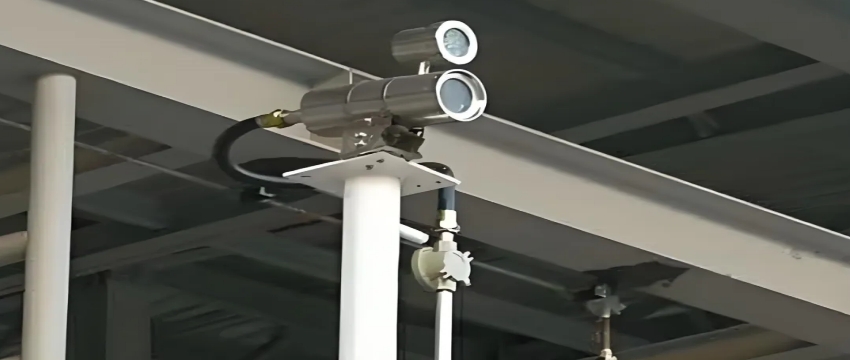What is explosion-proof camera, explosion-proof camera type
What are the special features of explosion-proof cameras?
Explosion-proof camera initial demand is from the coal mine, especially in the last decade, with the process of national industrialization, the demand for explosion-proof requirements to expand into various fields – petroleum, chemical industry, navigation, aerospace, metallurgy, scientific research and the military industry and other needs more. Explosion-proof cameras also began to be widely used in various fields.
State and production units on the “production safety” more and more attention, how to meet the monitoring and avoid triggering the danger has become the key, explosion-proof cameras as the monitoring of the production of flammable and explosive hazardous materials, storage of basic equipment to play a huge role.
First, the special features of explosion-proof cameras
1, the difference between explosion-proof cameras and ordinary cameras
Explosion-proof cameras in the optoelectronic structure and ordinary industrial cameras are not essentially different. Its most important feature is the use of one or more explosion-proof form of industrial camera processing, so that it can monitor the flammable and explosive site environment.
2, explosion-proof cameras and riot cameras of various different
1 Conceptual differences
Explosion-proof camera belongs to the explosion-proof monitoring products, explosion-proof industry with the monitoring industry cross-products, because in the high-risk flammable, explosive site can not use conventional camera products, the need for explosion-proof features and have the relevant certificates issued by the national authority to call the product explosion-proof camera.
Vandal-proof cameras are also known as high-security cameras, impact-resistant cameras, strike-resistant cameras, vandal-proof cameras. As the name suggests, the vandalism camera is in the external violent blows can still ensure that the components of the normal work of the camera, characterized by its shell has a strong impact resistance.
2 Different areas of application
Explosion-proof cameras in the petroleum, chemical, coal and scientific research, military and many other enterprises or research departments, in the process of experimentation, production, processing, transportation and storage, often may leak and overflow a variety of flammable and explosive gases, liquids and various dust and fibers, such substances mixed with air, will become prone to explosive hazardous mixtures, it is near the site has become an explosion of varying degrees of risk! place, and the concentration of explosive mixtures may continue to rise. When the concentration of explosive substances to reach the critical point of explosion, once the detonation source of sparks, arcs and high temperatures will produce explosions, fires and other serious accidents, resulting in casualties and property damage. In order to realize the flammable and explosive field environment in the application of monitoring, explosion-proof camera came into being.
The application of anti-vandalism camera is mainly concentrated in the financial, public security, prisons, business, subway, mining and relatively harsh environment, it can not only be used to deal with man-made vandalism, but also to deal with the harsh natural and production environment, to reduce them to the camera caused by the destructive effect.
3 Production process is different
At present, the international mainstream explosion-proof camera is explosion-proof, explosion-proof camera is “explosion-proof shield” + ordinary camera + lens. Vandal-resistant cameras are mostly hemispherical or spherical design, so the camera’s transparent shield and the upper shell of the manufacturing process, will become directly related to the camera’s ability to prevent the strength of the key to violence. In order to achieve the requirements of anti-violence, more and more products of the transparent shield are used in the polycarbonate (PC) engineering plastics to produce, there are also some manufacturers of products using polymethyl methacrylate (PMMA) engineering plastics (acrylic, acrylic) ball cover.
Second, explosion-proof camera types
There are three types of explosion-proof cameras on the market today: intrinsically safe, positive pressure, and explosion-proof.
”Intrinsically safe” is to limit the energy in the circuit from the beginning, the camera through the internal parameters of the reliable control circuit will potentially reduce the spark energy to ignite the specified gas mixture below the energy, wire and component surface heating temperature is limited to the specified gas mixture below the ignition temperature. All circuits within the camera are by the standard conditions (including normal operation and the prescribed failure conditions), any spark or any thermal effect can not ignite the prescribed intrinsically safe circuit of the explosive gas environment, due to the “intrinsically safe” camera is more expensive, now rarely seen on the market.
“Positive Pressure” explosion-proof type, which is to maintain a continuous air or inert gas inside the camera to limit the entry of combustible mixtures into the camera through the housing.
The most common explosion-proof cameras on the market is a “explosion-proof” explosion-proof type, it is the camera may ignite explosive gas mixtures of components all enclosed in a shell, the shell can withstand any joints or structural gaps through the shell, penetrate into the shell of the internal combustible mixture explosion in the internal without damage, and will not cause the external by one or more gases or vapors to form an explosive environment ignition. And will not cause the ignition of the external explosive environment formed by one or more gases or vapors. The camera may produce sparks, arcs and dangerous temperatures of the parts are put into the explosion-proof housing, explosion-proof housing so that the internal space of the camera is separated from the surrounding environment.
Explosion-proof shell gap, due to electrical equipment breathing and gas permeability, so that there may be explosive gas mixtures inside, when it explodes, the shell can withstand the resulting explosive pressure without damage, while the shell structure gap can cool the flame, reduce the flame propagation speed or terminate the acceleration chain, so that the flame or dangerous flame generators can not be traversed through the explosion-proof gap to ignite the external explosive environment, thus to achieve the purpose of explosion-proof.

